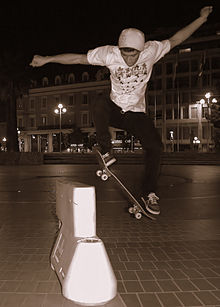Ollie (skateboarding)

The ollie is an aerial skateboarding trick, invented by Alan "Ollie" Gelfand in 1976 [1] and later adapted to flat ground by Rodney Mullen. The ollie serves as a basis for many other skateboarding tricks, such as the kickflip, heelflip and pop-shove it.
Records

The highest official ollie from flat ground is 44.55 inches (113 centimeters), performed by Danny Wainwright at the Reese Forbes Ollie Challenge by Quiksilver, although Jose Marabotto from Peru was seen on a video from the early '90s clearing a stack of boards estimated at over 50 inches (127 cm).[2] The highest official switch ollie is 40.125 inches (101.92 cm), performed by Alex Bland in a similar switch ollie competition.[3]
Variations
- Nollie, an Ollie done with the nose of the board instead of the tail.
- Switch Ollie, an Ollie done while riding switch.
- Fakie Ollie, an Ollie done while riding fakie.
- Ollie North, an Ollie where the front foot is kicked forward over the nose of the board. Sometimes called a one-foot ollie, even though both feet are used to perform the trick.
- Boned Ollie, an ollie where the board is dipped down and the legs are practically horizontal, similar to a "Melon Grab" however there is no grab.
Notes and references
- ^ Snyder, Craig Gasbag, Transworld Skateboarding Magazine (October 2005, p. 44)
- ^ ""Ollie" Skateboarding Dictionary". Retrieved 2007-10-20.
- ^ "ollie". Retrieved 2007-10-20.
